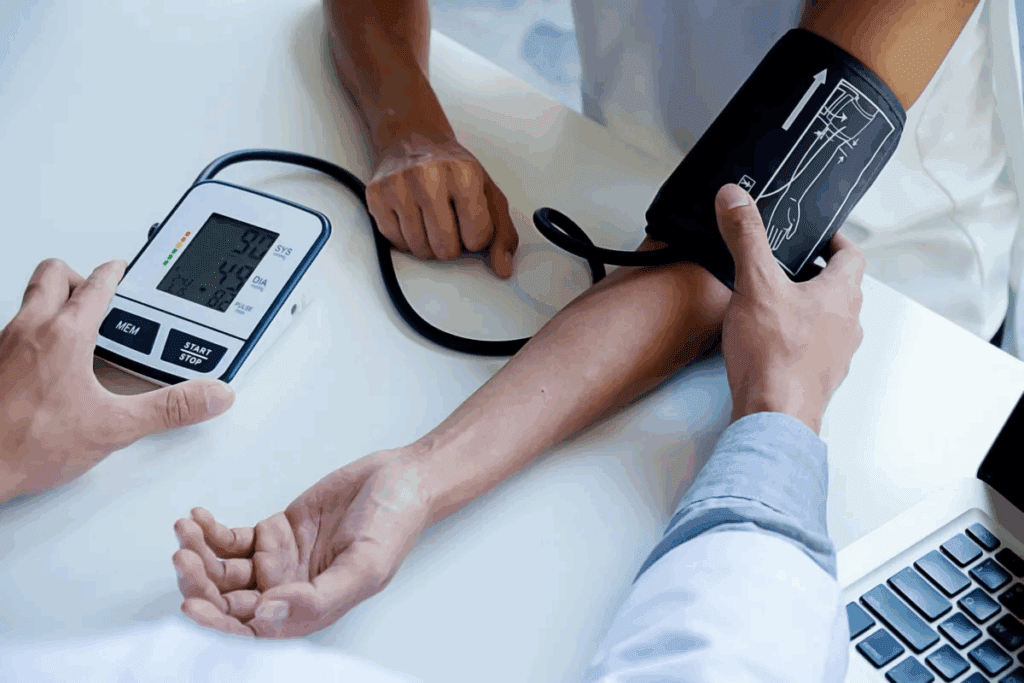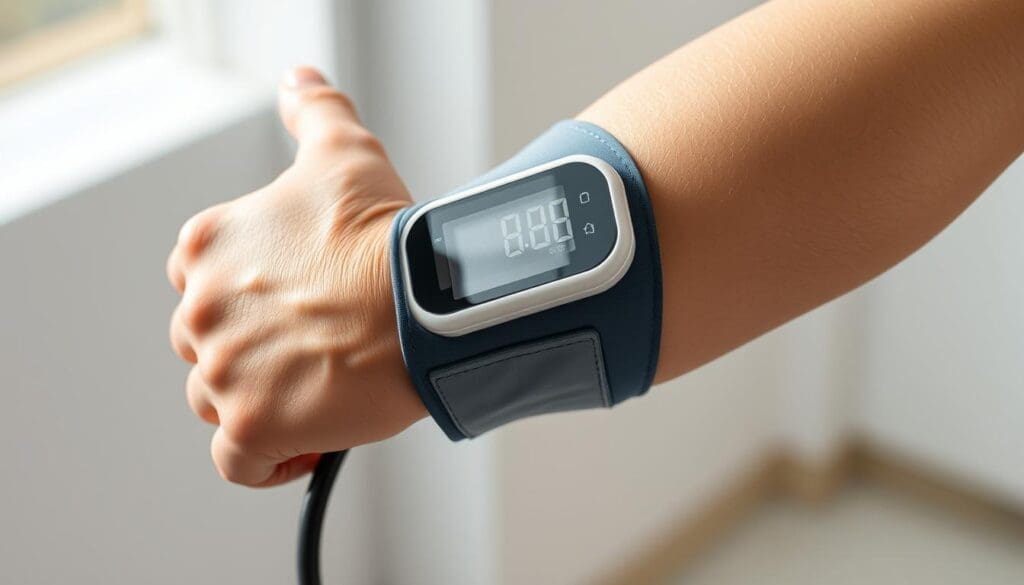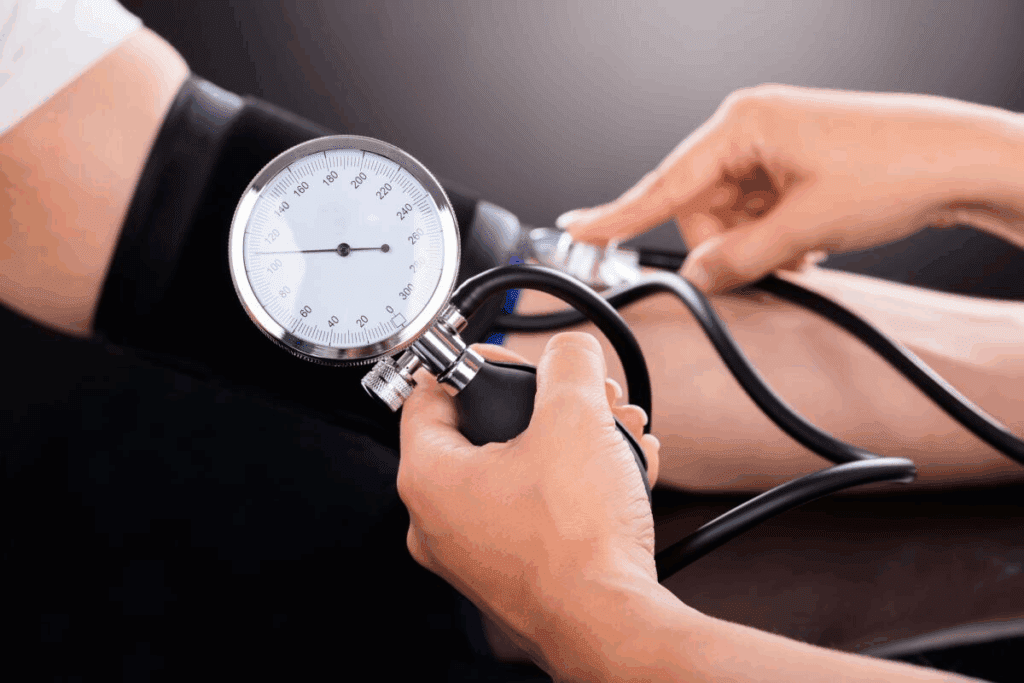
Learn if is low blood pressure harmful, when to worry, and how to identify dangerous symptoms.
Low blood pressure, or hypotension, is when your blood pressure is below 90 systolic over 60 diastolic (90/60 mmHg). Some people don’t have problems with low blood pressure. But, a reading of 90/40 mmHg can be risky. It might make you feel dizzy, weak, or even faint.
At Liv Hospital, we know how vital it is to watch your blood pressure. We help you spot when it’s a problem. Our goal is to keep your heart and mind safe with top-notch care for any blood pressure concerns.

It’s key to know about hypotension for good heart health. Low blood pressure, or hypotension, means blood flow to organs is not enough. This can harm or stop organs from working right.
Low blood pressure is when your reading is under 90/60 mmHg. The systolic pressure is when the heart beats, and the diastolic pressure is between beats. A reading under 90 mmHg systolic or 60 mmHg diastolic is low.
To measure blood pressure, you use a sphygmomanometer, which can be manual or digital. You wrap a cuff around your upper arm, inflate it, and then slowly let the air out. You listen with a stethoscope or digital sensors for blood flow sounds. Getting the measurement right is key to spotting hypotension.
Hypotension can hit anyone, but some are more at risk. Older people, those on certain meds, and those with heart or endocrine issues are more likely. Knowing these risks helps catch and manage hypotension early.

Knowing the difference between normal and low blood pressure is key for heart health. Blood pressure shows how hard blood pushes against artery walls as the heart pumps it. This is important for keeping the body healthy.
Normal blood pressure is usually 120/80 mmHg or less. The American Heart Association says this is the best range. Staying in this range can lower the risk of heart disease.
Key characteristics of normal blood pressure include:
Low blood pressure, or hypotension, is below 90/60 mmHg. It can cause blood flow problems, leading to dizziness and fainting.
Low blood pressure is a worry if it causes symptoms or drops suddenly. Chronic hypotension might not show symptoms right away. So, it’s important to check it regularly.
The 90/60 mmHg mark is when blood pressure is considered low. At this point, some people might start feeling symptoms from poor blood flow.
For some, 90/60 mmHg is fine, but for others, it can cause dizziness or fainting. Knowing how your body reacts to blood pressure changes is important.
Doctors look at many things, like your health and medical history, to decide if your blood pressure is a problem.
It’s important to know how low blood pressure affects the body. Low blood pressure, or hypotension, can impact people differently. Some may not feel any bad effects, while others may face serious health issues.
In some cases, low blood pressure is a good sign. It can mean the heart is working well, which is great for athletes or very fit people. But, it’s key to tell the difference between normal blood pressure changes and low blood pressure that might mean there’s a problem.
While low blood pressure can be good in some situations, chronic hypotension is not. It can cause blood flow problems to important organs. This can lead to damage over time. Some risks include:
Low blood pressure is a big worry because it affects organ perfusion. When blood pressure is too low, organs don’t get the oxygen and nutrients they need. This can cause problems like kidney issues, brain function problems, and even organ failure. Keeping blood flow to organs right is key to staying healthy and avoiding damage.
The question of how low blood pressure can safely go is complex. It varies a lot among individuals. Some people might not have problems with low blood pressure, while others could face serious health risks. It’s important to understand these differences to find safe lower limits.
People’s tolerance to low blood pressure, or hypotension, can vary a lot. This is due to factors like health, age, and physical condition. For example, athletes or very fit individuals might have lower blood pressure without issues. But for others, low blood pressure can cause problems with blood flow to vital organs.
A blood pressure reading below 90/60 mmHg is in the danger zone. At this level, some people might feel dizzy, faint, or have poor blood flow to important organs. It’s key to check blood pressure often and watch for any changes or symptoms.
A blood pressure reading of 90/40 mmHg is low and serious. The systolic pressure (90 mmHg) shows the pressure in arteries when the heart beats. The diastolic pressure (40 mmHg) shows the pressure between beats. Such a reading could mean poor blood circulation, which could harm organs if not treated. If you have this blood pressure and symptoms like confusion, chest pain, or severe headache, seek medical help.
In conclusion, there’s no single answer to how low blood pressure can safely go. Knowing the danger zone and understanding individual tolerance helps manage hypotension well. Regular monitoring and medical check-ups are key to keeping your heart healthy.
It’s important to know the warning signs of low blood pressure. This condition, known as hypotension, can be silent but shows symptoms that warn of danger. We’ll look at the key signs to watch for.
The first signs of low blood pressure are often subtle but critical. They include:
As a medical expert says, “Spotting these signs early can stop bigger problems.”
“Hypotension can lead to inadequate perfusion of vital organs, which, if left unchecked, may result in serious health issues.”
Low blood pressure can cause severe symptoms needing quick medical help. These include:
Low blood pressure raises the risk of falls and injuries. Dizziness or fainting from low blood pressure can cause falls. These falls can lead to serious injuries, mainly in older adults.
To lower this risk, people with low blood pressure should:
By spotting the danger signs of low blood pressure and knowing the fall risk, people can manage their condition better. This helps prevent serious problems.
Knowing when low blood pressure is dangerous is key to keeping your heart healthy. Low blood pressure, or hypotension, is when your reading is below 90/60 mmHg. But, how dangerous it is can depend on many things.
A very low blood pressure can cause organs to not get enough blood. This can lead to damage. Critical thresholds are when the risk of damage goes up a lot. For adults, a systolic below 80 mmHg or a diastolic below 50 mmHg is a warning sign.
Low blood pressure can cause dizziness, fainting, or even shock. In bad cases, it can be deadly. Knowing these levels is important for quick medical help.
The danger of low blood pressure isn’t just about the numbers. Many contextual factors also matter. These include your health, past medical issues, and any current conditions.
In some cases, low blood pressure is very serious and needs quick medical help. This happens when it doesn’t let vital organs get enough blood. Symptoms can include confusion, chest pain, or severe weakness.
If you or someone you know has these symptoms, call for emergency help right away. Quick treatment can prevent serious damage and improve health outcomes.
Low blood pressure is not usually a sign of a heart attack. But, very low blood pressure during a heart attack can mean the heart is not working well. It’s important to know this to spot health risks.
Low blood pressure, or hypotension, is not a direct sign of a heart attack. But, very low blood pressure during a heart attack can mean the heart is severely failing.
A heart attack happens when blood flow to the heart stops, damaging the heart muscle. High blood pressure is a known risk for heart attacks, but low blood pressure is not usually linked to them.
A heart attack can cause low blood pressure because the heart can’t pump blood well. Damage to the heart muscle during a heart attack can weaken the heart’s pumping ability, leading to low blood pressure.
This low blood pressure can cause poor blood flow to important organs, leading to more problems. It’s key to know the signs of a heart attack and get medical help right away to avoid lasting damage.
Low blood pressure can come from many causes, both heart-related and not. Heart-related causes include heart attacks, heart failure, and arrhythmias. Non-heart causes can be dehydration, blood loss, severe infections, or allergic reactions.
| Cause | Description | Potential Symptoms |
| Cardiac Causes | Heart attack, heart failure, arrhythmias | Chest pain, shortness of breath, dizziness |
| Non-Cardiac Causes | Dehydration, blood loss, severe infection | Fatigue, fainting, rapid heartbeat |
Knowing why someone has low blood pressure is key for the right treatment. Doctors use tests and patient history to find the cause and plan treatment.
Knowing the warning signs of low blood pressure is key. We need to spot symptoms that mean we should get help fast. This can prevent serious problems.
Some symptoms mean low blood pressure is a medical emergency. These include:
When you call for emergency help, give as much info as you can. Be ready to:
When you get to the hospital, doctors will quickly check you and start treatment. They might:
Quick medical help can greatly improve your chances of recovery from low blood pressure. If you see any red flag symptoms, get emergency help right away.
Managing low blood pressure needs a mix of medical help, diet changes, and lifestyle tweaks. Knowing the different treatments helps people work with doctors to create a plan that fits their needs.
At times, low blood pressure needs medical help, like if it’s caused by another condition or is very severe. Doctors might prescribe medicines to help control it.
It’s important to follow a doctor’s advice when taking these medicines. They can have side effects and interact with other drugs.
Changing what you eat is key in managing low blood pressure. Adding certain nutrients and paying attention to meal makeup can help keep blood pressure stable.
| Dietary Change | Benefit |
| Increasing salt intake | Helps retain fluid in the body, potentially increasing blood pressure. |
| Eating smaller, more frequent meals | Reduces postprandial hypotension by minimizing the amount of blood directed to the digestive system at one time. |
| Consuming foods rich in vitamin B12 | Essential for the production of red blood cells, which carry oxygen throughout the body. |
“A well-balanced diet that includes essential nutrients can significantly impact blood pressure management.”
Medical Expert
Making lifestyle changes is also important in managing low blood pressure. Simple changes in daily habits can make a big difference.
Recommended Lifestyle Changes:
By adding these changes to your daily life, you can better manage low blood pressure. This can also lower the chance of serious problems.
We’ve looked into the details of low blood pressure, its risks, and how to manage it. Knowing the signs and following treatment plans is key. This way, people can handle low blood pressure well.
Handling low blood pressure needs a mix of medical care, diet changes, and lifestyle tweaks. It’s important to work with doctors to create a plan that fits you. This might mean changing meds, eating more salt, or using compression socks.
Understanding and managing low blood pressure can lower risks and boost life quality. We urge those with hypotension to stay alert, watch their health, and get medical help when needed. This ensures they manage their condition safely and effectively.
Low blood pressure, or hypotension, is when your blood pressure is below 90/60 mmHg. But, it can depend on your health and other factors.
Low blood pressure might mean a heart attack if you also have chest pain or trouble breathing. But, it can also be from other reasons.
Blood pressure below 80/50 mmHg is risky, with symptoms like dizziness or fainting.
Signs include dizziness, feeling lightheaded, fainting, weakness, and fatigue. Severe cases might cause confusion or loss of consciousness.
Low blood pressure itself doesn’t usually cause heart attacks. But, it can be a sign of problems that might lead to heart issues if not treated.
Treatment depends on why your blood pressure is low. It might include diet changes, lifestyle changes, medicines, or medical help to keep your blood pressure stable.
For some, like athletes, low blood pressure might be okay if they don’t have symptoms. But, for others, it could mean health problems.
A safe reading is usually above 90/60 mmHg. This is normal or low but not dangerous for most people.
Call for emergency help if you faint, feel confused, or have a very low reading. Do this if you also have other serious symptoms.
Yes, eating more salt, staying hydrated, and eating small meals often can help manage low blood pressure.
Yes, regular exercise, avoiding long standing, and managing stress can help keep your blood pressure stable.
National Center for Biotechnology Information. (2025). Is Low Blood Pressure Harmful When to Worry. Retrieved from is low blood pressure harmful
Subscribe to our e-newsletter to stay informed about the latest innovations in the world of health and exclusive offers!
WhatsApp us